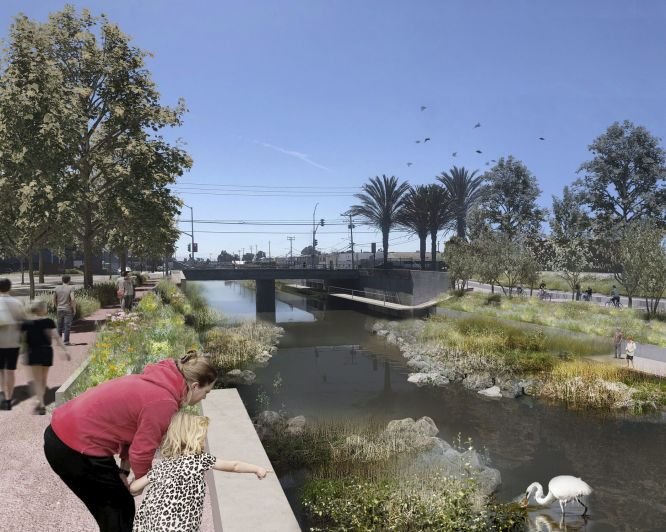Colma Creek in San Francisco
Hassell’s proposal for the 3.2 kilometre corridor of Colma Creek in South San Francisco won a 2021 Australian Institute of Landscape Architecture award in the international category.
The design addresses the impacts of rising sea levels in the Bay Area, and aims to manage flooding, restore ecology and access to the water, expand the number of parks and open spaces, and build environmental stewardship.
Hassell’s proposal for the two-mile corridor of Colma Creek in South San Francisco addresses the impacts of rising sea levels in the Bay Area.
Hassell say the corridor “has enormous potential to connect people with the creek and the bay. Both a priority conservation area and a key link to the Bay Trail, the creek could be restored to bring back wildlife and create healthy, public open spaces for people to enjoy.”
Running from San Bruno Mountain to the bay, most of the channel is concrete bordered by flood control walls. Limited public access leaves it essentially as a barrier to the surrounding community. Sea level rise projections say the creek will start to flood more often unless mitigation work begins now.
The proposal won a 2021 Australian Institute of Landscape Architecture award in the international category.
Hassell formed a strong partnership with the community and local groups over an 18-month period, hosting events, providing educational resources, and even releasing a multi-lingual children’s book. The AILA jury noted this offered an opportunity to, “form a community of stewards that might play a more active role in the creek’s ecology into the future.”
The plan opens the creek to Orange Park, softening the edge with new vegetation and terraced seating that brings people down to the water. Pedestrian and bike access will be added along the creek’s northern edge, as well as trees for shade and more green spaces near the water.
More trees, swales and rain gardens will be added to the streets to collect and treat runoff, while new brackish marshland will accomodate a range of salt and freshwater species in a dynamic tidal habitat.
The design aims to manage flooding, restore ecology and access to the water, expand the number of parks and open spaces, and build environmental stewardship.
Rocky edges and outcrops will be added to this new habitat, and native flowers planted for birds and butterflies. Widened and restored marsh prepares for a sea level rise while a shoreline boardwalk features structures for outdoor teaching and birdwatching.
The AILA jury commented that Hassell’s design, “expands the creek’s hydrological capacity, its environmental role and its system of access,” and commended the project’s, “acknowledgement of the local community’s active role in the site’s ecology, and the way it has developed engagement strategies to build stronger, ongoing ties between the community and the creek, set it apart from other projects of a similar nature.”
The Hassell team says the corridor has enormous potential to connect people with the creek and the Bay.



